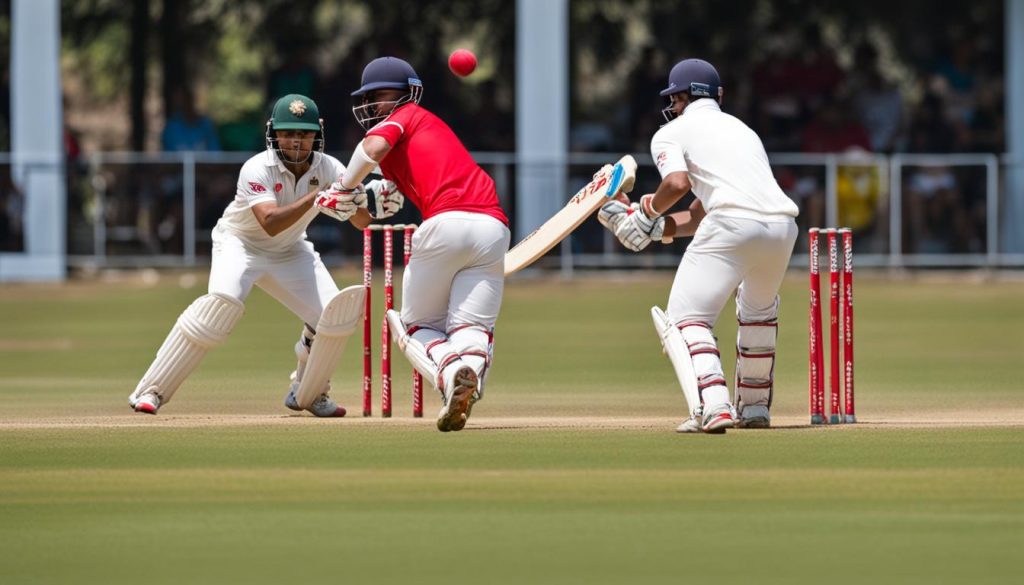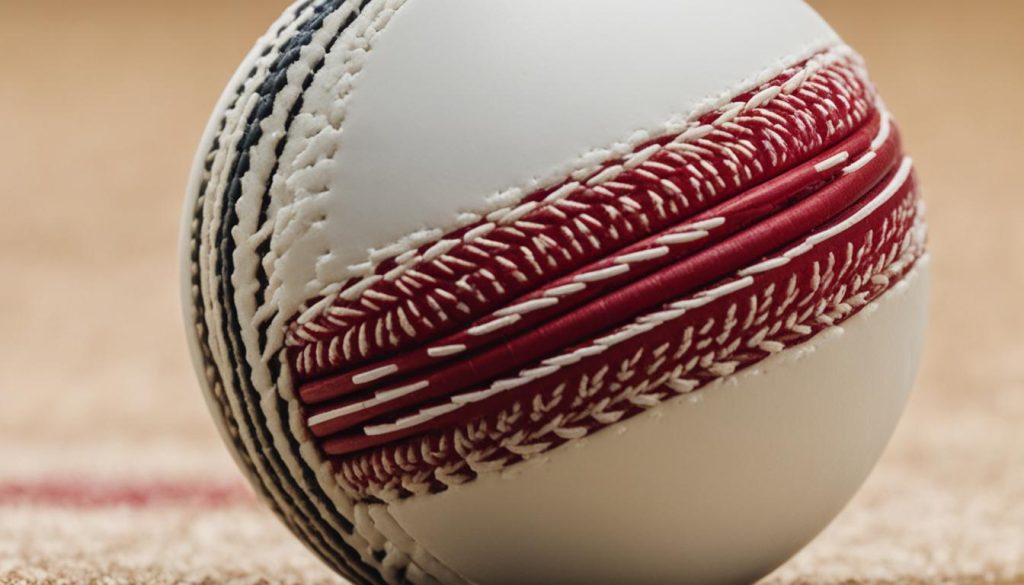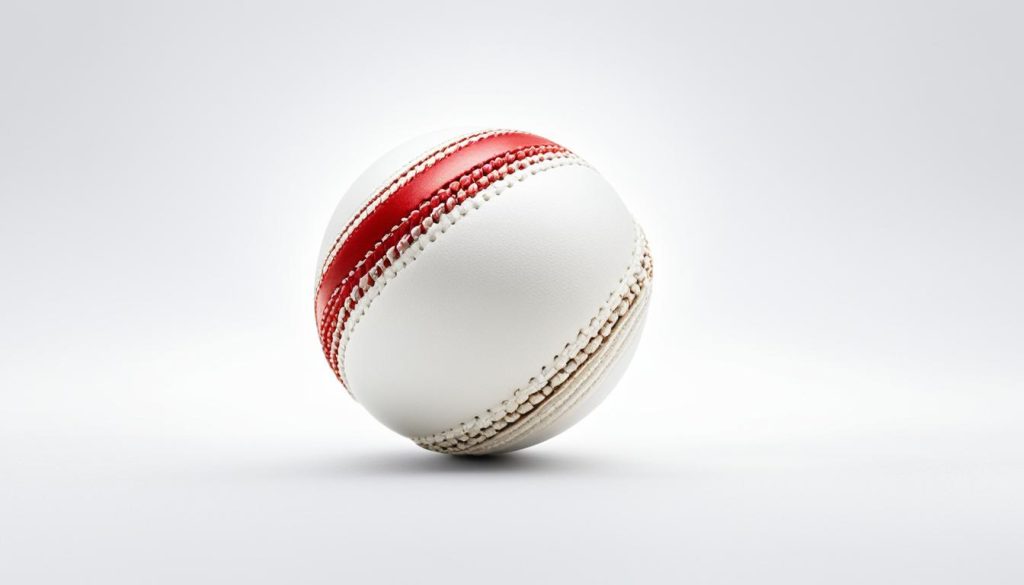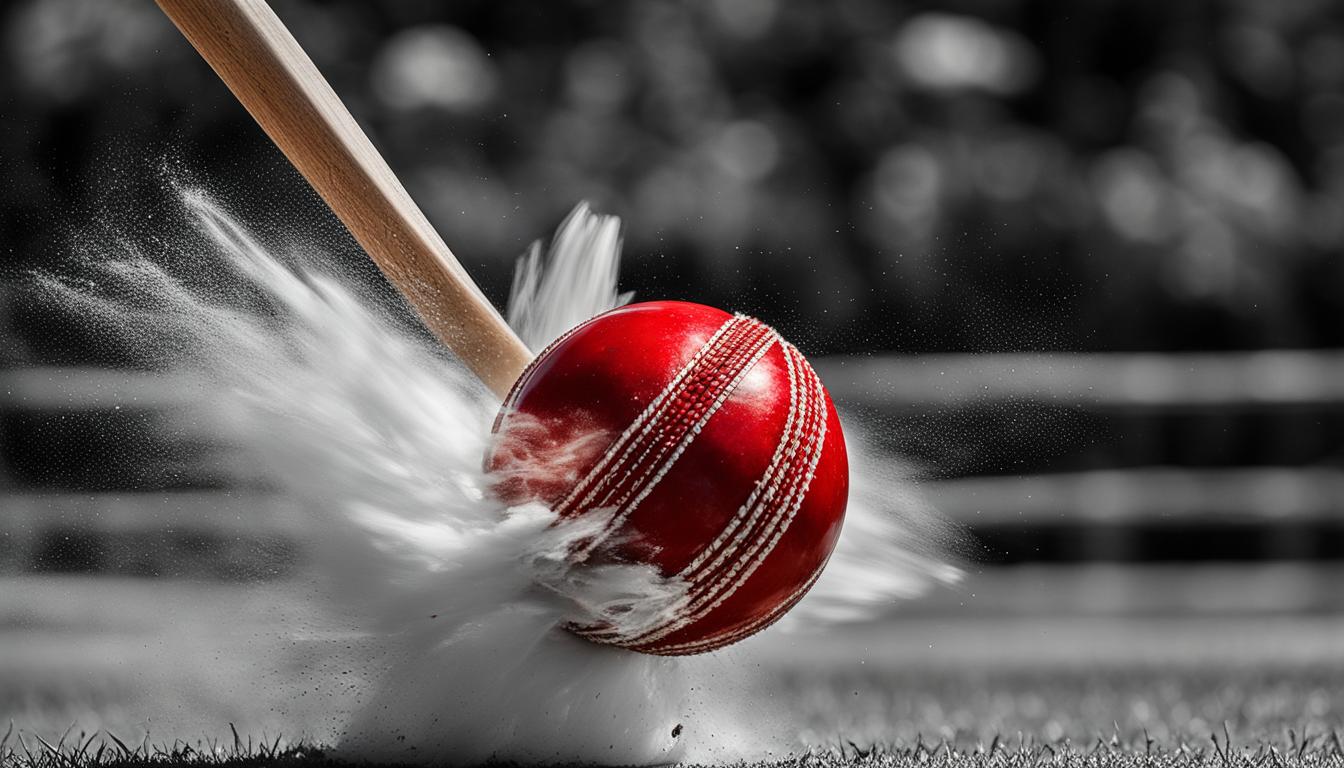As a cricket enthusiast, I’ve witnessed firsthand the pivotal role that the red and white ball plays in the electrifying drama of cricket. From the hallowed grounds of test match venues where the red ball dances in broad daylight to the vibrant floodlit stadiums where the white ball zips through the night, these colors do more than just embellish the game; they narrate a story of tradition, evolution, and sportsmanship. Today, I’m peeling back the layers of this color-coded narrative to reveal how these two spherical icons have shaped the sport loved by millions around the globe.
Test matches, celebrated as cricket’s most enduring format, have maintained the use of the red ball, a nod to the game’s rich history. Conversely, the advent of the white ball has instigated a fresh epoch in limited-overs cricket, attracting new audiences and bringing a dynamic edge to the game. Through the lens of these colored spheres, we witness the essence of cricket drama unfold, where every seam movement and swing has the power to keep the crowd on the edge of their seats.
Key Takeaways
- The red ball’s heritage is a testament to cricket’s traditions, pivotal in test matches.
- Introduction of the white ball signified the evolution and dynamism in limited-overs cricket.
- Cricket drama isn’t just about the players’ prowess, but also the peculiarities of the ball in play.
- Sportsmanship in cricket extends beyond the field to the respect for the game’s elements, including the red and white ball.
- Catering to cricket enthusiasts involves an understanding of how ball color affects the viewing experience.
The Significance of the Red and White Ball in Cricket History
As a cricket enthusiast and seasoned sports journalist, I reflect on the enduring legacy of the red and white ball within cricket’s tapestry. Test matches have long been painted in the glorious hue of the traditional red ball, a symbol deeply entrenched in cricket history. Its prominence in the sport is not just about the vibrant color; it’s a representation of an era characterized by endurance and skill, mirroring the time-honored customs of cricket.

Conversely, the white ball added a new dimension to cricket. With its inception in ODIs and T20 formats, the white ball broke from tradition and ushered in a pacey, upbeat era that appeals to the modern spectator. The white ball’s introduction was not solely a stylistic choice; it addressed the pragmatic needs of visibility under floodlights— a substantial shift considering cricket’s adaptation to nocturnal entertainment.
The red and white ball have become intrinsic to the character of cricket, influencing not only the aesthetic but also the game’s dynamics. While test matches remain a stronghold for the red ball, providing a seamless connection to the past, white balls have become synonymous with vibrant, energetic cricket evenings—each color echoing a distinct narrative of the sport’s evolution.
It is clear that the adoption of the white ball for night games was a turning point, offering spectators and players alike a better viewing experience that adapts to the demands of contemporary cricket. Yet, through the shifting paradigms of international cricket, the red ball endures, a steadfast emblem of the game’s storied past and a touchstone for cricket purists.
The discourse around these two hued spheres goes beyond mere color preference; it’s a reflection of cricket’s ability to respect its heritage while embracing innovation. As I continue to chronicle the stories shaped by the red and white ball, I am reminded that their journey through cricket history is far from over, promising further chapters in the captivating saga of test matches, ODI, and T20 competitions.
A Tale of Two Colors: How Red and White Balls Revolutionized the Game
In my exploration of cricket’s ongoing evolution, I’ve noted a distinct shift in match conditions with the introduction of the red and white ball. This innovation has had significant implications for both the viewing and playing experience in cricket. The white ball, in particular, has carved out its niche in providing enhanced ball visibility, especially under the glare of floodlights during night matches, thereby propelling a cricket revolution
The debate concerning the contrasting performance of the red and white ball is as enduring as the game itself. Differences in manufacturing, coupled with the material composition of the balls, have led to varied behaviors on the field. These developments underscore the compelling dynamics that these two colors have brought to cricket, influencing tactics and strategies across the international realm.
- Ball Visibility: The white ball’s prominence against both the pitch and outfield ensures that players and audiences can track its movement with clarity.
- Swing Factors: The fascinating discussion around the swing capabilities of red versus white balls illuminates the nuanced technical aspects pivotal to match conditions.
- Strategic Dimensions: The choice of ball color has become a strategic consideration, impacting gameplay across different formats of the sport.
| Ball Color | Preferred Match Format | Visibility Conditions | Swing Behavior |
|---|---|---|---|
| Red | Test Matches | Day, Natural Light | Varied with wear, more traditional swing |
| White | ODIs, T20s | Night, Artificial Lighting | Reported to swing more initially |
| Pink | Day/Night Tests | Twilight Conditions | Combines qualities of red and white |
In summary, it’s fascinating to witness how the red and white ball have jointly engineered a seismic shift within cricket’s venerable confines. Their respective attributes have not only achieved greater visibility during matches but have also spiced up the contest between bat and ball, a cornerstone of this cherished sport.
Red and White Ball: A Comparative Analysis of Swing Behaviour
As a cricket enthusiast, I’ve followed the debate on whether the color of a cricket ball affects its swing dynamics. Recent discussions about red and white ball comparison have particularly piqued my interest. It is often claimed that the cricket ball manufacturing process, especially the dye used, significantly determines the ball’s behavior during a game.
The Impact of Dyes on the Swing Dynamics of Cricket Balls
The color coating is not just for show; it affects the swing dynamics of a ball. Typically, a white ball is reported to swing more than its red counterpart. This claim stems from the notion that the chemicals used in the white dye might alter the ball’s surface properties, affecting the aerodynamics.
Ball Condition and Swing: Contrasting Red Versus White Balls
In examining ball condition, it’s known that newer balls favor a conventional swing while used ones lean towards reverse swing. I’ve observed that white balls, given their use in shorter formats, are less exposed to prolonged roughing up compared to red balls in test matches. This distinction in wear-and-tear could contribute to differing swing patterns.

Cricket Ball Manufacturing: Quality that Influences Performance
Premier brands like Kookaburra stand by the consistency in quality and performance between their red and white balls. Yet, I can’t help but consider how the sophisticated manufacturing process influences a ball’s abilities to sustain its condition and swing over the course of a game.
| Ball Type | Swing Potential | Formats Used | Typical Life Span |
|---|---|---|---|
| Red Ball | Conventional swing, adapts to reverse | Test matches | 80 overs |
| White Ball | Greater initial swing | ODIs, T20s | 25-50 overs |
When I step out onto the field or tune in to watch a match, I’m reminded that the nexus of swing dynamics, ball condition, and meticulous cricket ball manufacturing harbors a silent but striking impact on the red and white saga of cricket.
From the Pitch to the Stands: Enhanced Visibility with the White Ball
When the floodlights beam down on the cricket pitch, the unforgettable sight of a white ball cutting through the dusk elevates the player and spectator experience alike. I’ve witnessed firsthand how the advent of the white ball has revolutionized the game, primarily by bolstering white ball visibility. This innovation has indeed been a game-changer, particularly for day-night matches where it’s paramount for players to track the ball effectively.

The contrast of the white ball against the green field and brownish pitch allows for acute perception, reducing the risk of players losing sight of the ball during critical moments of play. Moreover, as someone who savors the sport from both perspectives—player and spectator—I can validate that the enhanced visibility makes a substantial difference, not just in gameplay, but in the collective excitement of the audience.
“From the thunderous cheers to the gasps of anticipation, it’s the clarity with which we witness each delivery that defines our experience,” a fellow spectator once shared, encapsulating how vital visibility is for engaging spectators.
| Aspect | Importance for Players | Importance for Spectators |
|---|---|---|
| Visibility under lights | Better tracking during high-speed deliveries | Improved clarity when following the ball |
| Color contrast | Enhances reaction time for fielding and batting | Augments the viewing experience, making it easier to see boundaries and catches |
| Day-Night matches | Influences strategic play and ball choices | Offers a comfortable viewing period, increasing engagement |
The transition from red to white in limited-overs cricket certainly wasn’t a superficial decision driven by aesthetics; it was a pragmatic shift, tweaking the game for the better. For us as spectators, we are no longer mere onlookers but engaged participants, reveling in the thrill of every white blur racing towards the boundary. On the field, each player’s potential is maximized, not by chance, but through the meticulous choice of equipment—where the white ball has unequivocally claimed its place in the vibrant tapestry of cricket.
Choosing the Right Cricket Ball: The Importance of Quality and Branding
In my experience as both a player and a passionate follower of international cricket, I’ve observed that choosing the right cricket ball is a decision that cannot be taken lightly. The performance on the pitch can hinge on the cricket ball quality, which is significantly influenced by respected cricket ball brands like Kookaburra, Dukes, and SG. Understanding the attributes of each brand aids in making an informed choice that is suitable for the various conditions seen in international cricket.
Branded Balls and Their Place in International Cricket
Brands like Kookaburra, Dukes, and SG carry a signature significance in the realm of cricket. Each brand has carved out its territory, with Kookaburra being the popular choice in Australia and Oceania, Dukes reigning in England, and SG being the go-to in India. I’ve noted that these brands have earned trust and respect over the years for their consistent quality and performance, a criterion that stands paramount especially in the rigor of international cricket.
Performance Differences Among Popular Cricket Ball Brands
It’s intriguing to dissect the performance intricacies associated with the leading cricket ball brands. On close inspection, I’ve realized that each brand brings something unique to the game. For instance:
- Kookaburra balls are renowned for their ability to retain shape and offer a consistent bounce and swing over extended play.
- Dukes are often praised for their pronounced seam which can be a bowler’s ally, aiding in swing and grip on the pitch.
- SG balls, on the other hand, are appreciated for their durability and the pronounced seam, which can persist longer to support spin and reverse swing.
In summary, the decision when choosing cricket balls has ramifications extending to every delivery bowled and every shot played in the international arena.
How does the Material of a Cricket Ball Affect the Drama in Cricket Matches?
The material of a cricket ball plays a crucial role in crafting excellence in cricket. A harder, smoother ball can help bowlers achieve greater speed and swing, leading to more dramatic and challenging matches. On the other hand, a softer ball allows for longer play and strategic batting, creating intense suspense for the fans.
Conclusion: Embracing the Evolution of the Cricket Ball
As someone deeply invested in the world of cricket, I’ve observed the remarkable journey of the cricket ball. Its transformation from the iconic red to the innovative white and pink variants represents more than a mere color change—it signals the continuous evolution and adaptation required to meet the demands of a global sport. Today, we see a game that’s constantly modernizing, with cricket ball evolution being a pivotal area of technological advancement and strategic significance. The innate nature of competition pushes for future cricket ball innovations that aim to enhance the sport’s appeal and maintain its integrity.
The Future of Cricket Balls: Innovations and Adaptations
Looking ahead, the prospects of innovation in cricket ball design are boundless. I envision future advancements that not only improve visibility and aerodynamics but also redefine how the game is played. With ongoing research and development, the next generation of cricket balls could well offer unique challenges to players, provoking new strategies and potentially altering the very fabric of the sport. It’s exhilarating to anticipate the innovations and adaptations that the next wave of cricketing gear will bring to the pitch.
Cricket Balls and Player Safety: Protective Gear in the Sport
Amid the excitement of innovation, the issue of player safety stands at the forefront. The cricket ball, by its nature, is a potential hazard, capable of inflicting serious injury. This reality underscores the necessity for high-quality protective cricket gear. As the ball evolves, so too must the equipment designed to safeguard the players. My commitment to promoting safety in the sport is unwavering—I champion developments that place as much emphasis on player well-being as on performance. Ensuring cricket ball safety is not just a regulatory responsibility, it’s a moral imperative for the industry and community alike.
FAQ
What is the significance of the red and white ball in cricket history?
The red ball has been a fundamental part of cricket history, traditionally used in test matches as a symbol of the sport’s heritage. The white ball was introduced for ODI and T20 matches, marking an evolution in the game. Their respective uses reflect the sport’s adaptation to varied match conditions and advancements over time.
How did the introduction of the white ball revolutionize cricket?
The white ball was a game-changer for cricket, particularly for limited-over matches and night games where visibility became crucial. Its introduction improved the visibility for players and spectators, ensuring the sport could adapt to modern demands such as night matches and enhanced spectatorship in varying lighting conditions.
What are the swing dynamics between the red and white cricket balls?
While many claim that the dye distinguishing the red and white balls is the primary factor contributing to their different swing behaviors, various factors influence swing dynamics. These include the ball’s condition (new vs. old), atmospheric conditions, and the quality of manufacturing. There is a common observation among players and researchers that the white ball tends to swing more.
Does the cricket ball color affect player and spectator experience?
Absolutely. The white ball was introduced to enhance visibility on the pitch and in the stands, particularly under artificial light during night matches. This has had a significant impact on player performance and the viewing experience, making cricket more accessible and enjoyable for spectators in various playing conditions.
How important is the brand when choosing a cricket ball for international matches?
The brand of a cricket ball is a critical decision in international matches because different brands like Kookaburra, Dukes, and SG offer balls with unique qualities. These qualities can impact the game’s outcome due to differences in wear resistance, seam prominence, and swing behavior. Therefore, the choice of a cricket ball brand involves strategic consideration for peak performance.
What innovations and adaptations might we see in the future of cricket balls?
The cricket ball has undergone continual evolution, with the introduction of new colors like pink for better night-time visibility. Future innovations may involve advanced materials or design changes that could affect how the ball moves through the air or bounces on the pitch. Additionally, in the interest of player safety, we might see adaptations that aim to reduce injury risk without compromising the quality of play.
How does cricket ball safety and protective gear factor into the sport?
Cricket ball safety is paramount, as the sport involves a hard, fast-moving ball that can pose significant injury risks. Protective gear is essential for player safety, and ongoing enhancements to equipment like helmets, pads, and gloves continue to be a focal point. The development of safer cricket balls without sacrificing performance is also an aspect of the sport’s evolution that garners attention.






